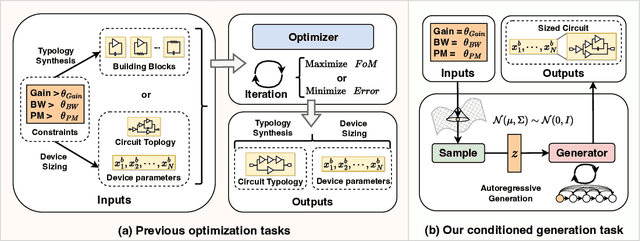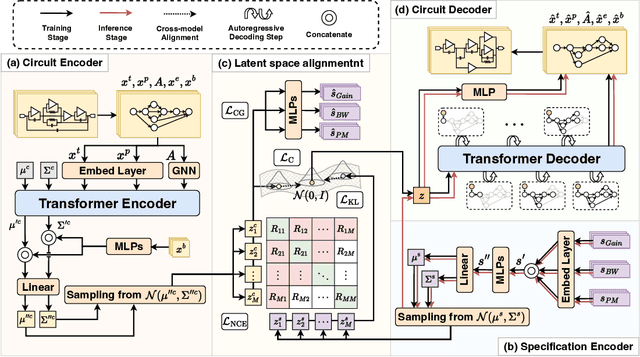Min Zhou
FactorHD: A Hyperdimensional Computing Model for Multi-Object Multi-Class Representation and Factorization
Jul 16, 2025Abstract:Neuro-symbolic artificial intelligence (neuro-symbolic AI) excels in logical analysis and reasoning. Hyperdimensional Computing (HDC), a promising brain-inspired computational model, is integral to neuro-symbolic AI. Various HDC models have been proposed to represent class-instance and class-class relations, but when representing the more complex class-subclass relation, where multiple objects associate different levels of classes and subclasses, they face challenges for factorization, a crucial task for neuro-symbolic AI systems. In this article, we propose FactorHD, a novel HDC model capable of representing and factorizing the complex class-subclass relation efficiently. FactorHD features a symbolic encoding method that embeds an extra memorization clause, preserving more information for multiple objects. In addition, it employs an efficient factorization algorithm that selectively eliminates redundant classes by identifying the memorization clause of the target class. Such model significantly enhances computing efficiency and accuracy in representing and factorizing multiple objects with class-subclass relation, overcoming limitations of existing HDC models such as "superposition catastrophe" and "the problem of 2". Evaluations show that FactorHD achieves approximately 5667x speedup at a representation size of 10^9 compared to existing HDC models. When integrated with the ResNet-18 neural network, FactorHD achieves 92.48% factorization accuracy on the Cifar-10 dataset.
ALF: Advertiser Large Foundation Model for Multi-Modal Advertiser Understanding
Apr 26, 2025Abstract:We present ALF (Advertiser Large Foundation model), a multi-modal transformer architecture for understanding advertiser behavior and intent across text, image, video and structured data modalities. Through contrastive learning and multi-task optimization, ALF creates unified advertiser representations that capture both content and behavioral patterns. Our model achieves state-of-the-art performance on critical tasks including fraud detection, policy violation identification, and advertiser similarity matching. In production deployment, ALF reduces false positives by 90% while maintaining 99.8% precision on abuse detection tasks. The architecture's effectiveness stems from its novel combination of multi-modal transformations, inter-sample attention mechanism, spectrally normalized projections, and calibrated probabilistic outputs.
PosterMaker: Towards High-Quality Product Poster Generation with Accurate Text Rendering
Apr 09, 2025Abstract:Product posters, which integrate subject, scene, and text, are crucial promotional tools for attracting customers. Creating such posters using modern image generation methods is valuable, while the main challenge lies in accurately rendering text, especially for complex writing systems like Chinese, which contains over 10,000 individual characters. In this work, we identify the key to precise text rendering as constructing a character-discriminative visual feature as a control signal. Based on this insight, we propose a robust character-wise representation as control and we develop TextRenderNet, which achieves a high text rendering accuracy of over 90%. Another challenge in poster generation is maintaining the fidelity of user-specific products. We address this by introducing SceneGenNet, an inpainting-based model, and propose subject fidelity feedback learning to further enhance fidelity. Based on TextRenderNet and SceneGenNet, we present PosterMaker, an end-to-end generation framework. To optimize PosterMaker efficiently, we implement a two-stage training strategy that decouples text rendering and background generation learning. Experimental results show that PosterMaker outperforms existing baselines by a remarkable margin, which demonstrates its effectiveness.
PAID: A Framework of Product-Centric Advertising Image Design
Jan 24, 2025Abstract:In E-commerce platforms, a full advertising image is composed of a background image and marketing taglines. Automatic ad image design reduces human costs and plays a crucial role. For the convenience of users, a novel automatic framework named Product-Centric Advertising Image Design (PAID) is proposed in this work. PAID takes the product foreground image, required taglines, and target size as input and creates an ad image automatically. PAID consists of four sequential stages: prompt generation, layout generation, background image generation, and graphics rendering. Different expert models are trained to conduct these sub-tasks. A visual language model (VLM) based prompt generation model is leveraged to produce a product-matching background prompt. The layout generation model jointly predicts text and image layout according to the background prompt, product, and taglines to achieve the best harmony. An SDXL-based layout-controlled inpainting model is trained to generate an aesthetic background image. Previous ad image design methods take a background image as input and then predict the layout of taglines, which limits the spatial layout due to fixed image content. Innovatively, our PAID adjusts the stages to produce an unrestricted layout. To complete the PAID framework, we created two high-quality datasets, PITA and PIL. Extensive experimental results show that PAID creates more visually pleasing advertising images than previous methods.
SceneBooth: Diffusion-based Framework for Subject-preserved Text-to-Image Generation
Jan 07, 2025



Abstract:Due to the demand for personalizing image generation, subject-driven text-to-image generation method, which creates novel renditions of an input subject based on text prompts, has received growing research interest. Existing methods often learn subject representation and incorporate it into the prompt embedding to guide image generation, but they struggle with preserving subject fidelity. To solve this issue, this paper approaches a novel framework named SceneBooth for subject-preserved text-to-image generation, which consumes inputs of a subject image, object phrases and text prompts. Instead of learning the subject representation and generating a subject, our SceneBooth fixes the given subject image and generates its background image guided by the text prompts. To this end, our SceneBooth introduces two key components, i.e., a multimodal layout generation module and a background painting module. The former determines the position and scale of the subject by generating appropriate scene layouts that align with text captions, object phrases, and subject visual information. The latter integrates two adapters (ControlNet and Gated Self-Attention) into the latent diffusion model to generate a background that harmonizes with the subject guided by scene layouts and text descriptions. In this manner, our SceneBooth ensures accurate preservation of the subject's appearance in the output. Quantitative and qualitative experimental results demonstrate that SceneBooth significantly outperforms baseline methods in terms of subject preservation, image harmonization and overall quality.
Low-Rank Adaptation for Foundation Models: A Comprehensive Review
Dec 31, 2024Abstract:The rapid advancement of foundation modelslarge-scale neural networks trained on diverse, extensive datasetshas revolutionized artificial intelligence, enabling unprecedented advancements across domains such as natural language processing, computer vision, and scientific discovery. However, the substantial parameter count of these models, often reaching billions or trillions, poses significant challenges in adapting them to specific downstream tasks. Low-Rank Adaptation (LoRA) has emerged as a highly promising approach for mitigating these challenges, offering a parameter-efficient mechanism to fine-tune foundation models with minimal computational overhead. This survey provides the first comprehensive review of LoRA techniques beyond large Language Models to general foundation models, including recent techniques foundations, emerging frontiers and applications of low-rank adaptation across multiple domains. Finally, this survey discusses key challenges and future research directions in theoretical understanding, scalability, and robustness. This survey serves as a valuable resource for researchers and practitioners working with efficient foundation model adaptation.
GraphMoRE: Mitigating Topological Heterogeneity via Mixture of Riemannian Experts
Dec 15, 2024



Abstract:Real-world graphs have inherently complex and diverse topological patterns, known as topological heterogeneity. Most existing works learn graph representation in a single constant curvature space that is insufficient to match the complex geometric shapes, resulting in low-quality embeddings with high distortion. This also constitutes a critical challenge for graph foundation models, which are expected to uniformly handle a wide variety of diverse graph data. Recent studies have indicated that product manifold gains the possibility to address topological heterogeneity. However, the product manifold is still homogeneous, which is inadequate and inflexible for representing the mixed heterogeneous topology. In this paper, we propose a novel Graph Mixture of Riemannian Experts (GraphMoRE) framework to effectively tackle topological heterogeneity by personalized fine-grained topology geometry pattern preservation. Specifically, to minimize the embedding distortion, we propose a topology-aware gating mechanism to select the optimal embedding space for each node. By fusing the outputs of diverse Riemannian experts with learned gating weights, we construct personalized mixed curvature spaces for nodes, effectively embedding the graph into a heterogeneous manifold with varying curvatures at different points. Furthermore, to fairly measure pairwise distances between different embedding spaces, we present a concise and effective alignment strategy. Extensive experiments on real-world and synthetic datasets demonstrate that our method achieves superior performance with lower distortion, highlighting its potential for modeling complex graphs with topological heterogeneity, and providing a novel architectural perspective for graph foundation models.
CktGen: Specification-Conditioned Analog Circuit Generation
Oct 01, 2024



Abstract:Automatic synthesis of analog circuits presents significant challenges. Existing methods usually treat the task as optimization problems, which limits their transferability and reusability for new requirements. To address this limitation, we introduce a task that directly generates analog circuits based on specified specifications, termed specification-conditioned analog circuit generation. Specifically, we propose CktGen, a simple yet effective variational autoencoder (VAE) model, that maps specifications and circuits into a joint latent space, and reconstructs the circuit from the latent. Moreover, given that a single specification can correspond to multiple distinct circuits, simply minimizing the distance between the mapped latent representations of the circuit and specification does not capture these one-to-many relationships. To address this, we integrate contrastive learning and classifier guidance to prevent model collapse. We conduct comprehensive experiments on the Open Circuit Benchmark (OCB) and introduce new evaluation metrics for cross-model consistency in the specification-to-circuit generation task. Experimental results demonstrate substantial improvements over existing state-of-the-art methods.
Towards reliable respiratory disease diagnosis based on cough sounds and vision transformers
Sep 03, 2024Abstract:Recent advancements in deep learning techniques have sparked performance boosts in various real-world applications including disease diagnosis based on multi-modal medical data. Cough sound data-based respiratory disease (e.g., COVID-19 and Chronic Obstructive Pulmonary Disease) diagnosis has also attracted much attention. However, existing works usually utilise traditional machine learning or deep models of moderate scales. On the other hand, the developed approaches are trained and evaluated on small-scale data due to the difficulty of curating and annotating clinical data on scale. To address these issues in prior works, we create a unified framework to evaluate various deep models from lightweight Convolutional Neural Networks (e.g., ResNet18) to modern vision transformers and compare their performance in respiratory disease classification. Based on the observations from such an extensive empirical study, we propose a novel approach to cough-based disease classification based on both self-supervised and supervised learning on a large-scale cough data set. Experimental results demonstrate our proposed approach outperforms prior arts consistently on two benchmark datasets for COVID-19 diagnosis and a proprietary dataset for COPD/non-COPD classification with an AUROC of 92.5%.
You Can't Ignore Either: Unifying Structure and Feature Denoising for Robust Graph Learning
Aug 01, 2024Abstract:Recent research on the robustness of Graph Neural Networks (GNNs) under noises or attacks has attracted great attention due to its importance in real-world applications. Most previous methods explore a single noise source, recovering corrupt node embedding by reliable structures bias or developing structure learning with reliable node features. However, the noises and attacks may come from both structures and features in graphs, making the graph denoising a dilemma and challenging problem. In this paper, we develop a unified graph denoising (UGD) framework to unravel the deadlock between structure and feature denoising. Specifically, a high-order neighborhood proximity evaluation method is proposed to recognize noisy edges, considering features may be perturbed simultaneously. Moreover, we propose to refine noisy features with reconstruction based on a graph auto-encoder. An iterative updating algorithm is further designed to optimize the framework and acquire a clean graph, thus enabling robust graph learning for downstream tasks. Our UGD framework is self-supervised and can be easily implemented as a plug-and-play module. We carry out extensive experiments, which proves the effectiveness and advantages of our method. Code is avalaible at https://github.com/YoungTimmy/UGD.
 Add to Chrome
Add to Chrome Add to Firefox
Add to Firefox Add to Edge
Add to Edge